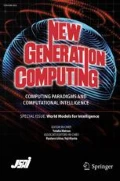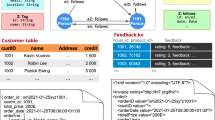Abstract
In order to formalize complex and compositional concepts, we propose a logical framework based on an upper ontology constructed from the composition of basic concepts such as properties and objects. In particular, ontologically distinct compositions (called ontological compositions) that are not easily defined by using ISA and PART-OF relations are classified into characterizing, temporal, and spatial compositions (e.g., ’red face’ and ’today’). In this paper, we precisely model such ontological compositions by using monadic second-order logic; properties and objects are expressed as predicates, and attributes are expressed as predicates of predicates. The proposed approach provides a novel technique for the classification of attributes as higher-order concepts, and it clarifies illegal compositions of properties and objects and the uniqueness of temporal attributes. Moreover, our composition ontology is described by a set of RDF triples using the metamodeling of concepts in RDF Schema.
Similar content being viewed by others
References
Baget, J., Croitoru, M., Gutierrez, A., Leclère, M. and Mugnier, M.-L., “Translations between rdf(s) and conceptual graphs,” in Proc. of the 18th International Conference on Conceptual Structures (ICCS 2010), LNCS, 6208, pp. 28–41 Springer, 2010.
Bettini, C., Jajodia, S. G. and Wang, S. X., Time Granularities in Databases, Data Mining and Temporal Reasoning, Springer-Verlag New York, Inc., Secaucus, NJ, USA, 2000.
Brickley, D. and Guha, R. V., “RDF Vocabulary Description Language 1.0: RDF Schema, W3C Recommendation,” http://www.w3.org/tr/2004/rec-rdf-schema-20040210/, Technical report, 2004.
5 Chen, W. and Kifer, M., “Sorted HiLog: Sorts in higher-order logic data languages,” in Proc. of the 5th International Conference on Database Theory (ICDT’95), LNCS, 893, pp. 252–265. Springer, 1995.
Dershowitz, N. and Reingold, E. M., Calendrical Calculations, Cambridge University Press, 1997.
Grenon, P. and Smith, B., “SNAP and SPAN: Towards dynamic spatial ontology,” Spatial Cognition & Computation, 4, 1, pp. 69–104, 2004.
Guarino, N. and Welty, C., “A formal ontology of properties,” in Proc. of EKAW-2000: The 12th International Conference on Knowledge Engineering and Knowledge Management, pp. 97–112, 2000.
Kaneiwa, K., “Order-sorted logic programming with predicate hierarchy,” Artificial Intelligence, 158, 2, pp. 155–188, 2004.
Kaneiwa, K. and Mizoguchi, R., “Ontological knowledge base reasoning with sort-hierarchy and rigidity,” in Proc. of the 9th International Conference on the Principles of Knowledge Representation and Reasoning (KR2004), pp. 278–288, 2004.
Kaneiwa, K. and Mizoguchi, R., “An order-sorted quantified modal logic for metaontology,” in Proc. of the International Conference on Automated Reasoning with Analytic Tableaux and Related Methods (TABLEAUX2005), pp. 169–184 LNCS, 3702, Springer–Verlag, 2005.
Kaneiwa, K. and Mizoguchi, R., “Distributed reasoning with ontologies and rules in order-sorted logic programming,” Journal of Web Semantics, 7, 3, pp. 252–270, 2009.
Gandon, F. and Schreiber, G., “RDF 1.1 XML Syntax, W3C Recommendation,” http://www.w3.org/TR/rdf-syntax-grammar/, 2014.
Loux, M. J. and Zimmerman, D. eds., Oxford Handbook of Metaphysics, Oxford University Press, 2003.
Lowe, E. J., The Four-Category Ontology: A Metaphysical Foundation for Natural Science, Oxford University Press, 2005.
Manzano, M. “Introduction to many-sorted logic,” in Many-sorted Logic and its Applications, pp. 3–86 John Wiley and Sons, 1993.
Masolo, C., Borgo, S., Gangemi, A., Guarino, N., Oltramari, A. and Schneider, L., “Wonderweb deliverable d17. the wonderweb library of foundational ontologies and the dolce ontology,” 2002.
Materna, P., “Concepts and objects,” Acta Philosophica Fennica, 63, 1997.
Motik, B., “On the Properties of Metamodeling in OWL,” Journal of Logic and Computation, 17, 4, pp. 617–637, 2007.
Ohlbach, H. J. and Gabbay, D. M., “Calendar logic,” Journal of Applied Non-Classical Logics, 8, 4, 1998.
Rosenkrantz, G. and Hoffman, J., “The independence criterion of substance,” Philosophy and Phenomenological Research, 51, 4, pp. 835–853, 1991.
Smith, B., “Basic concepts of formal ontology,” in Formal Ontology in Information Systems, 1998.
Tharp, L. H., “The characterization of monadic logic,” Journal of Symbolic Logic, 38, 3, pp. 481–488, 1973.
Welty, C. and Andersen, W., “Towards ontoclean 2.0: A framework for rigidity,” Applied Ontology, 1, 1, pp. 107–116, 2005.
Welty, C. and Guarino, N., “Supporting ontological analysis of taxonomic relationships,” Data and Knowledge Engineering, 39, 1, pp. 51–74, 2001.
Author information
Authors and Affiliations
Corresponding author
About this article
Cite this article
Kaneiwa, K., Mizoguchi, R. & Nguyen, P.H.P. A Logical and Ontological Framework for Compositional Concepts of Objects and Properties. New Gener. Comput. 33, 149–172 (2015). https://doi.org/10.1007/s00354-015-0203-9
Received:
Revised:
Published:
Issue Date:
DOI: https://doi.org/10.1007/s00354-015-0203-9




